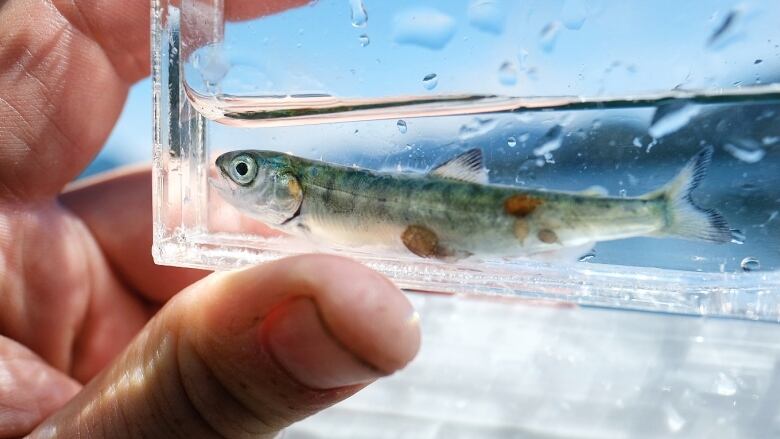Conservation groups sound alarm over another sea lice outbreak in Clayoquot Sound
Samples of vulnerable juvenile wild salmon also show infestations of the parasite

Conservation groups that monitor Clayoquot Sound are sounding the alarm for the second spring in a row about high levels of a parasite that can harm juvenile wild salmon.
Several salmon farms in the region on the west coast of Vancouver Island have again reported levels of sea lice in recent months that exceed what is allowed.
Under Pacific Aquaculture Regulations, fish farms must monitor and manage the parasite — which can be deadly to farmed and wild fish.
Conservation groups are worried sea lice at fish farms are having an impact on vulnerable juvenile wild salmon as they migrate out of rivers into Clayoquot Sound during the spring months.
Mack Bartlett has been doing weekly sampling of young wild fish at three sites as research co-ordinator at the Cedar Coast Field Station on Vargas Island.
Between 80 and 100 per cent of the fish sampled have showed signs of sea lice, he said.
"It's a really big issue because juvenile salmon do not have proper defences against sea lice infections," he said.
The parasite occurs naturally in Pacific Ocean waters, but it is usually found among adult salmon, which have defences such as scales that help protect them.
Changing conditions
The large concentrations of adult salmon in fish farm pens could be increasing the amount of sea lice in Clayoquot Sound, while also putting juvenile salmon in contact with adult salmon at a fragile time in their development, Bartlett said.
The parasite flourishes in warm, dry conditions that increase salinity in ocean water, something Clayoquot Sound has experienced again this year, he added.
Last year, half of Cermaq Canada's 14 salmon farms in Clayoquot Sound reported sea lice levels at or above the threshold that requires treatment under its federal licence.
Several of those same sites have struggled to control the parasite this spring, prompting the company to accelerate its harvest plan to deal with the situation.
Correlating what is happening at fish farms with the wild salmon population is difficult, said Linda Sams, Sustainable Development Director for Cermaq Canada.
But the company is taking steps to prevent future sea lice outbreaks, such as using a more effective anti-lice treatment called Lufenuron for the next crop of fish, and a $12 million barge called a hydrolicer that can manually remove sea lice from farmed fish.

"We need to eliminate our farms as one of the risks," she said. "We need to keep the levels low on our farms, and we know that."
Cermaq also does its own sampling of wild salmon to try to determine if the sea lice at fish farms are affecting the wild salmon population, but the results of this spring's sampling are not yet available, Sams said.
Warning letter
The sea lice at Cermaq farms have also prompted a warning letter from the federal minister of fisheries and oceans over a lack of compliance with licence conditions.
"It is important that companies who do business on the ocean follow the rules and guidelines outlined in the Fisheries Act," said a statement from Minister Jonathan Wilkinson.
"We will continue to communicate with Cermaq Canada and other companies to ensure that licence requirements are understood and followed."
But some conservation groups question why action was not taken sooner this spring to ensure wild salmon were not potentially exposed to sea lice at fish farms.
While Cermaq has harvested affected fish as quickly as its processing plant can take them, the process has taken months and the harvest at one fish farm with high sea lice levels won't be complete until next month.
Bonnie Glambeck, with the group Clayoquot Action, questions why federal officials did not demand quicker action to deal with the threat of sea lice, especially in light of dwindling wild salmon returns.
"Even though we have pristine habitat in Clayoqout Sound, our salmon populations are coming back being counted in the tens, rather than the tens of thousands," she said.
